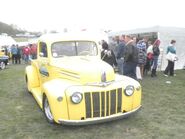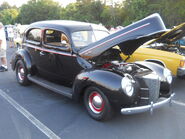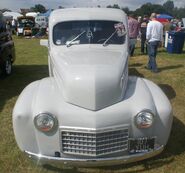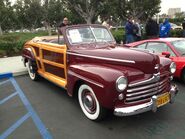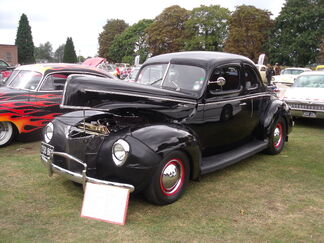
1941 Ford
The Ford car was thoroughly updated in 1941, in preparation for a time of unpredictability surrounding World War II.
The 1941 design would continue in an aborted 1942 model year and would be restarted in 1946 and produced until the more modern 1949 Fords were ready. During the initial year of this car, it evolved considerably. The front fenders came in three pieces, the theory being that small damage could be replaced easily. During the year, it evolved into 2 pieces with the lower front and back sections being joined. The hood risers changed, the early ones being the same as 1940 Fords, changing during the year to the better later version.
In the 1941 Convertible, there were no rear side windows, the only side windows being in the doors, in 1942, quarter windows were added so the rear occupants could see out. There were five different coil/distributor arrangements during 1941, causing confusion for mechanics. Other variations were: two different positions for the generator, and three for the cooling fan — front of the crankshaft, front of the generator (rare) and on a bracket. This is thought to be the first Ford to offer an oil filter. There were two interior heaters: a "Southwind" gasoline burner, which had the advantage of keeping you warm in winter at drive-in movies (provided you added a small electric fuel pump), and a more ordinary hot-water type. Both had window defrosters. It had an excellent radio, which could consume the battery in about 2 hours. Electric windshield wipers were available in addition to the vacuum-powered wipers. There were three different convertible power top mechanisms (vacuum, electric screw, and hydraulic), and two different header bar latching systems. Rear suspensions sometimes had a sway bar, most did not. It had excellent brakes for the era, and the best handling of an ordinary car at the time. It was a very transitional car.
The two previous Ford car lines, standard and De Luxe, had blossomed into three, Special, De Luxe, and Super De Luxe. This time, the entry-level 136 CID (2.2 L) V8 was deleted in favor of a new 226 CID (3.7 L) L-head straight-6, the first Ford six since the failed 1906 Model K. The popular 221 CID (3.6 L) V8 remained as the top-line engine and was standard in De Luxe models. Both engines were rated at 90 hp. The 239 CID engine, introduced in 1939 for Mercury and Trucks, was continued in the Mercury Models. The chassis was longer, with a 114 in (2896 mm) wheelbase.
The "ignition key" for these cars was actually used to operate a bolt lock which, on one end, unlocked the steering column (a feature destined to return, mandated, decades later), and on the other end unblocked the ignition switch, allowing it to be operated. Starting the car was then accomplished by pressing a pushbutton on the dashboard, another feature destined to return with the advent of "smart keys."
Although starting cranks had been replaced by electric starters for decades, Ford cars included a manual starting feature until 1948 as an antidote to dead-battery syndrome. The wheel-lug wrench served as a handle (also for the jack) and the jack shaft with bayonet-coupling pins could be inserted through a small hole in the grille to engage a bayonet socket on the forward end of the engine crankshaft. A quick-and-easy twist of the handle was sufficient to start the flat head V8, and the bayonet coupling was self-disengaging for safety.
1941[]
Fords for 1941 were much more modern with a wide body that nearly covered the running boards. The front and rear fenders were still pronounced, but were now integrated more into the body and the headlights were pushed all the way up and out over the front wheels. The 1941 grille was a three-part affair with a tall center section bookended by twin kidneys low on the fenders and vertical bars all around. The 1941 was a bigger car with a 194.3 in (4935 mm) overall length. Body styles included Tudor and Fordor sedans, a sedan coupe, a business coupe and convertible coupe, sedan delivery wagon, and woody station wagon. The pickup truck continued with the 1940 standard Ford styling.
1942[]
Ford halted its car and truck lines on February 10, 1942 to begin war production, but not before a short run of 1942 cars was built. Changes were made to the car besides a three-part "electric shaver" grille — and the parking lights were moved from the top of the fenders to between the grill and headlights. Tail lights were enlarged and moved from vertical to horizontal. the frame was lowered and softer springs were used to improve the ride. The dashboard was changed, moving the radio from the top of the dash to low down, and the linear speedometer and clock were replaced with round ones. The radio had an optional floor button so you could change preselected stations without moving your hands. War rationing required auto makers to black out their chrome trim, and a special four-door model was produced with no chrome at all for military use. The pickup received new styling as well, with heavy vertical bars, and truck production lasted through March 3.
It is certain that 1942-style Ford cars continued to be produced as military staff cars from March 1942 through summer 1945. These would have been registered as 1942, 1943, 1944, and 1945 models. Additionally, a large number of 1942 (and a few 1941) cars held in dealer stocks by government edict, to be doled out to essential users during the conflict, were Fords. Some states titled cars by the year of sale, so it is possible to find 1943, 1944, and 1945 models by virtue of their registrations and titles.
1946[]
Civilian production resumed in July 1945, with an early start to the 1946 model year filling the public's thirst for new cars. The 1946 Ford was identical to the 1942 model under the skin, though a heavy new grille with horizontal bars and red accents modernized the car somewhat. The hood was widened by adding a center strip. One notable change was to use the 239 CID engine which since 1939 had been used in Mercury and Trucks, and capable of 100 hp (75 kW)for the first time. With steel in short supply, Ford produced a distinctive "Sportsman" convertible with wood side panels. The convertible had an electric top instead of manual one.
In the film Back to the Future, Biff Tannen's car in 1955 was a black 1946 Ford Super De Luxe convertible. After the film, the car was kept by Universal and displayed in their back lot tour. Universal sold the car in 1996 to a private collector. The vehicle is now in a private collection in south eastern Wisconsin.
1947[]
The 1947 Ford line was similar to the short 1946. Visual differences included the removal of the red accents from the grill and the two small lights located just above it. Ford began titling 1947s in February 1947. For the first few weeks, the 1947 model was identical to the 1946. Ford then restyled the body slightly first by moving the parking lights from above the grill to below each headlight. Exterior moldings were changed from grooved to a smooth design. A new hood ornament with a blue plastic insert was installed. New hubcap design became available in March. Interior dash color was changed from red accent to gold. By September the roof mounted antenna was moved to the cowl. Horns were moved to in front of the radiator from the engine compartment. The final 1947 models were titled in November.
1948[]
1948 was the final year for the old-style Ford, with an all-new model launched partway through the year. The wood-sided Sportsman convertible would end this year with just 28 built, and the all-wood bodies on the woody station wagons would be replaced with steel for the 1949 season. The old car-based trucks were replaced by the F-Series this year.



